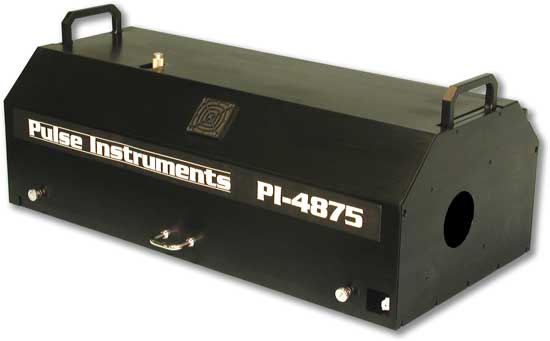| Home | |
| Turnkey Systems | |
| Products | |
|
|
Pattern Generators |
|
|
Clock Drivers |
|
|
|
|
|
Data Acquisition |
|
|
Mainframes |
|
|
Accessories |
| Software | |
| About | |
| Support | |
| News | |
| Contact/Sales | |
| Pulse Research Lab | |
| Top | |
|
*Discontinued*PI-4875 Visible Illumination Source |
|
Products > Photon Sources > PI-4875 |
|

|
|
Features:
|
Applications:
|
Discontinued:Pulse Instruments has suspended shipments of our Illuminator product. The information provided below is for support of our existing customers only, and we are not taking any new orders for Illuminators at this time. |
|
Introduction:Evaluation of the functional performance of visible imaging devices requires spatially uniform illumination. Commercially available test illumination sources currently on the market have a small area of illumination and non-uniformity that is greater than 3%. The production of uniform illumination (irradiance) of high intensity has always been a challenge. Existing illumination sources capable of providing spatial non-uniformity approaching 1% are traditionally based on an integrating sphere to produce the randomization of the energy distribution. Typically the integrating sphere is large and bulky. Pulse instruments has taken advantage of the properties of the integrating sphere but in a significantly smaller package. An optical system is added to the integrating sphere that preserves the uniformity and increases the area of illumination. Instrument DescriptionThe PI-4875 Precision Illumination Source developed by Pulse Instruments provides a spatially uniform distribution of irradiance over a large area. The large, uniform illumination area allows the testing of the larger devices, such as linear devices, without compromising the testing process. In addition this large area of illumination can be used to illuminate several smaller devices simultaneously for parallel testing. Specific spectral bandpass and irradiance levels are selectable through computer control. Narrow band interference filters determine specific spectral pass bands. These filters can have values throughout the illuminator spectral range of 400 nm to 1000 nm. A set of Inconel neutral density filters and the iris determine the irradiance level. The unit is low maintenance and can be mounted in any position to accommodate prober and part handler environments. The design is based on the use of a small integrating sphere. The neutral density and spectral bandpass filters process the output energy from the integrating sphere before being delivered to the optical system. A closed-loop monitoring system maintains the luminance stability to ±0.1% over a short period and less than ±1% over a long period. Located in the optical lens system is an iris type aperture. This iris is controllable from fully open to fully closed via the computer in 650 steps. One filter wheel holds up to 6 selectable bandpass filters that can be selected within the range of 400 nanometers to 1,000 nanometers. The second filter wheel holds up to 6 selectable neutral density filters. Using the iris and the neutral density filters together to control the output will provide a wide range of luminance. The user can incorporate a much wider selection of bandpass filters and/or neutral density filters with additional filter wheels. The PI-4875 incorporates a unique design that simplifies the changing of both the bandpass and neutral density filter wheels while maintaining optical alignment. A filter wheel can be changed in less than 60 seconds; typically it requires about 30 seconds. Therefore, the user can quickly reconfigure the illuminator to meet other test applications. Additional features of the PI-4875 Precision Illuminator are the ability to focus an image on the DUT and a monitoring detector to monitor the output of the illuminator at the DUT. These two functions are also under computer control. For image projection there is an arm that holds the desired image or target. This image, when placed in the light path, is projected on to the device under test. The image can be focused on the DUT by axial movement using a linear motion stage. The output monitoring function is a mirror that directs light energy to a detector for measurement. The mirror is not permanently in the light path but is switched into the light path on computer command. The Illuminator Support Instrumentation consists of the light source power supply, the integrating sphere monitor/controller and the control electronics for the control of the iris, target and focusing control, output monitor control and the control for the bandpass and neutral density filter wheels. These units are placed in a 19" cabinet with an AC Power Strip and included with the illuminator. The units are rack mountable so they can be integrated into your test system rack. Software DescriptionThe software for the PI-4875 Precision Illumination Source functions under the current versions of Windows 2000 or NT. The software controls the positioning of the neutral density filter wheel and the selection of the desired bandpass filter. This software also controls the aperture of the iris between fully open to closed. The other functions controlled by the software are selecting the mirror position for output luminance monitoring and selecting the target or image for focusing on the DUT. The target focus is controlled via the software by positioning the linear stage. The PI-4875 control software can be slaved to the user’s system software, such as PI-DATS (Pulse Instruments’ System Software) or LabView. |
|
Ordering Information:Contact Pulse Instruments Sales at (310) 515-5330 or by email at sales@pulseinstruments.com | |
Specifications | Datasheet |
|